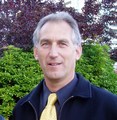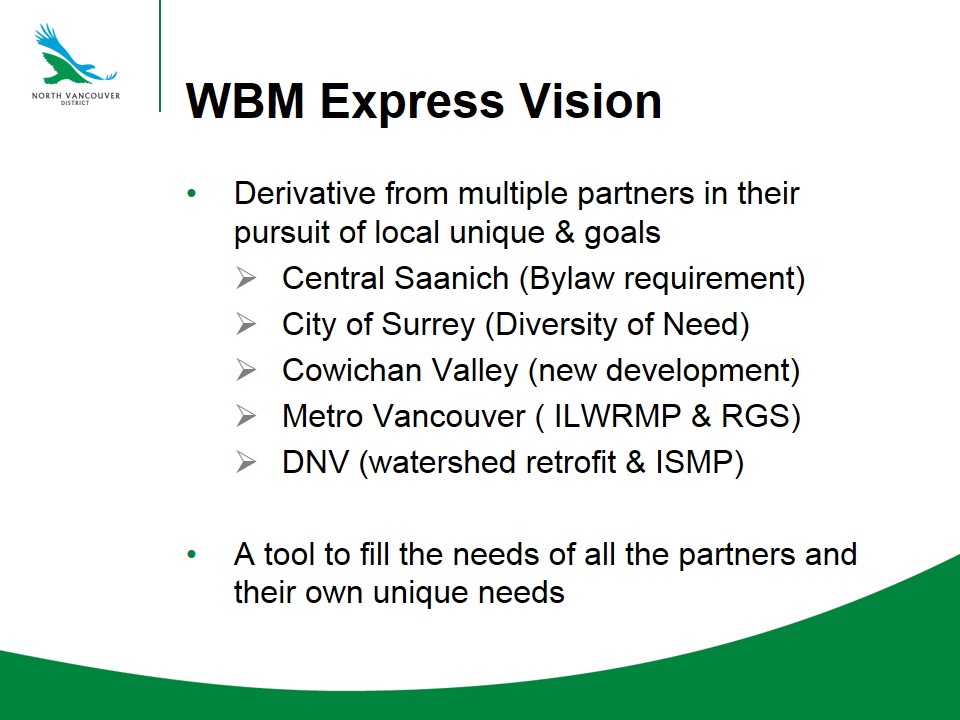WBM Express: Technical Session in August 2010 Identified Key Principles that have Guided Tool Development
Conceptual Framework for Initiating Development of WBM Express in 2010
In February 2010, the District of Central Saanich adopted its Surface Water Management Bylaw. Because the bylaw encourages homeowners to use the WBM to make decisions that achieve a lighter ‘hydrologic footprint’, the bylaw became the catalyst for action by the Water Balance Model Partnership to develop a homeowner version of the WBM.
The Partnership brought together a local government focus group for a brainstorming session hosted by Metro Vancouver in July 2010. A key outcome of the session was the decision to develop a ‘vision document’ that would serve two purposes: inform other WBM Partners; and lay the groundwork for securing grants to fund development of the WBM Express.
Building on the initial momentum generated by the focus group session, the next action by the Partnership was a working session with the WBM Technical Team in August 2010. That session fleshed out the concept for a homeowner version of the Water Balance Model.
Problem Statement
In terms of the analytical process for ‘lightening the hydrologic footprint’, the group distilled the problem statement as follows:
- What is there now on the property?
- What is the planned change?
- What can be done to mitigate the increase in runoff volume?
 “During the August 2010 working session, the technical team brainstormed and assessed the feasibility of a range of approaches to implementing the focus group vision for the WBM Express,” recalls Ted van der Gulik, Partnership Chair. “By the end of the day, Key Principles for the WBM Express had been identified. These would subsequently guide the initial phases of work plan development.”
“During the August 2010 working session, the technical team brainstormed and assessed the feasibility of a range of approaches to implementing the focus group vision for the WBM Express,” recalls Ted van der Gulik, Partnership Chair. “By the end of the day, Key Principles for the WBM Express had been identified. These would subsequently guide the initial phases of work plan development.”
Key Principles
- The WBM Express is a comparative tool that will enable comparison of scenarios.
- The WBM Express is an educational tool that will foster a change in the land ethic.
- The WBM Express will facilitate interaction between the property owner and the regulator.
- The first priority of the Partnership is to meet the regulatory needs of the focus group members.
- Partners will pool funding through the Partnership to develop a common framework and platform.
- Partners will be responsible for customizing WBM Express application to meet their individual needs.
- The platform architecture will allow for addition of plug-in modules.
- A local government must be a WBM Partner in order to use the WBM Express.
- Property owners would access the WBM Express via their local government website.
- Property owners would generate a standardized report that compares runoff volumes.
Project Vision
“The August 2010 session crystallized the importance of visualizing the WBM Express process as a simplified flowchart comprising three boxes: CALCULATION ENGINE – CONVERTER (i.e. the web interface) – DATABASE,” states Dr. Charles Rowney, Scientific Authority for the Water Balance Model program. “Hence, the technical team concluded that the Project Vision would need to focus on how the Converter would enable homeowners to lighten their hydrologic footprints; and in so doing achieve the performance target objectives of local governments in a watershed context to protect stream health.”
CONVERTER (i.e. the web interface) – DATABASE,” states Dr. Charles Rowney, Scientific Authority for the Water Balance Model program. “Hence, the technical team concluded that the Project Vision would need to focus on how the Converter would enable homeowners to lighten their hydrologic footprints; and in so doing achieve the performance target objectives of local governments in a watershed context to protect stream health.”


